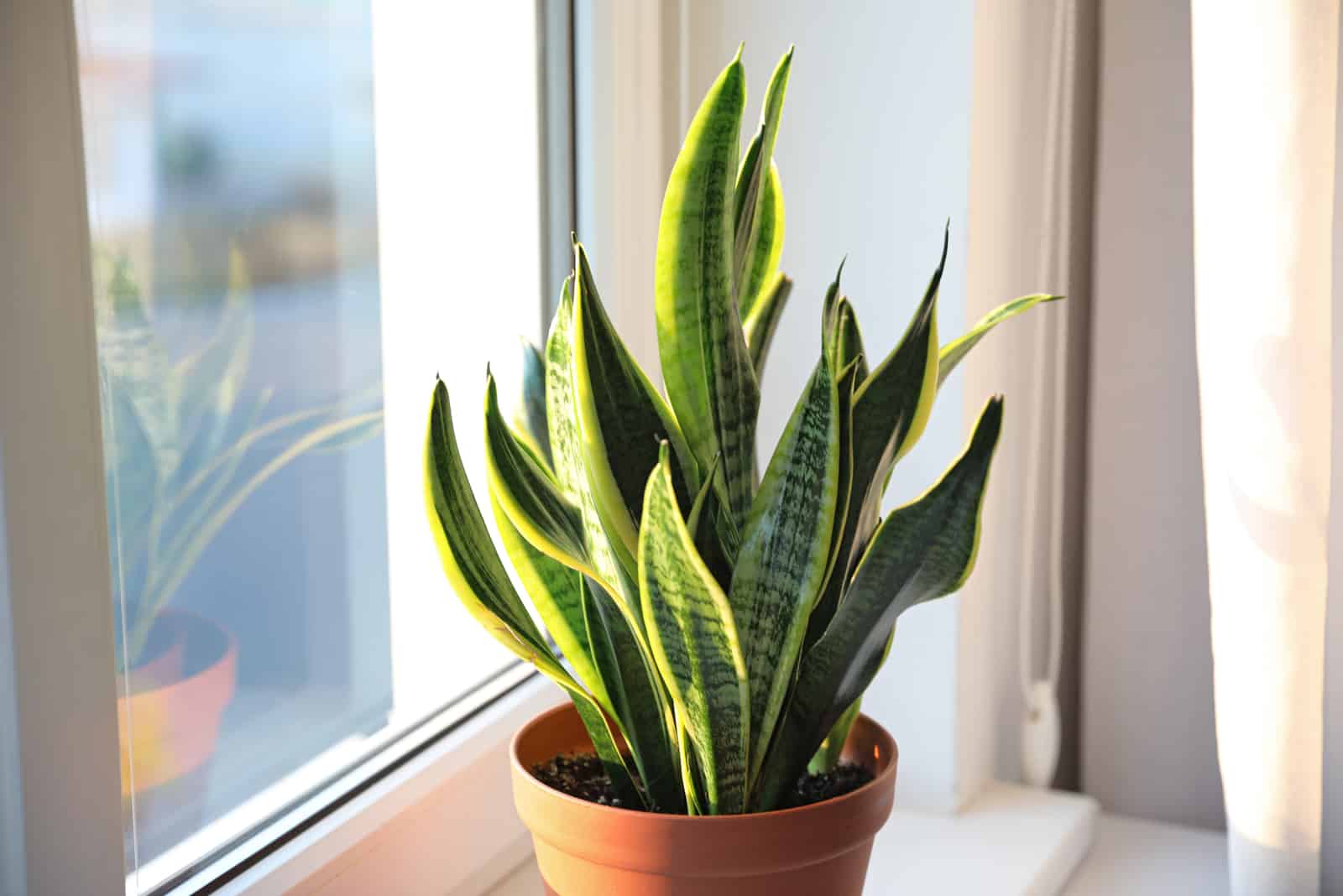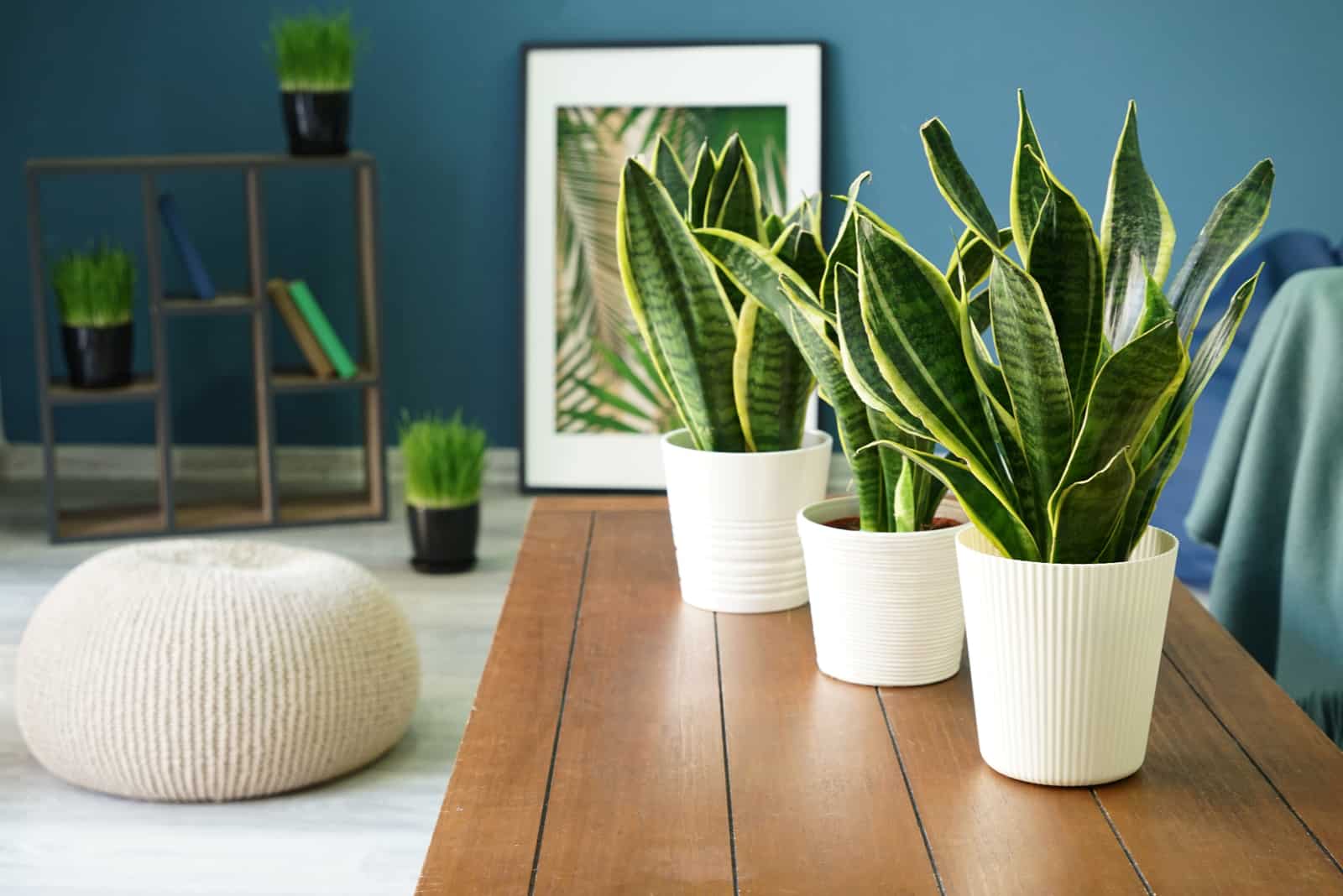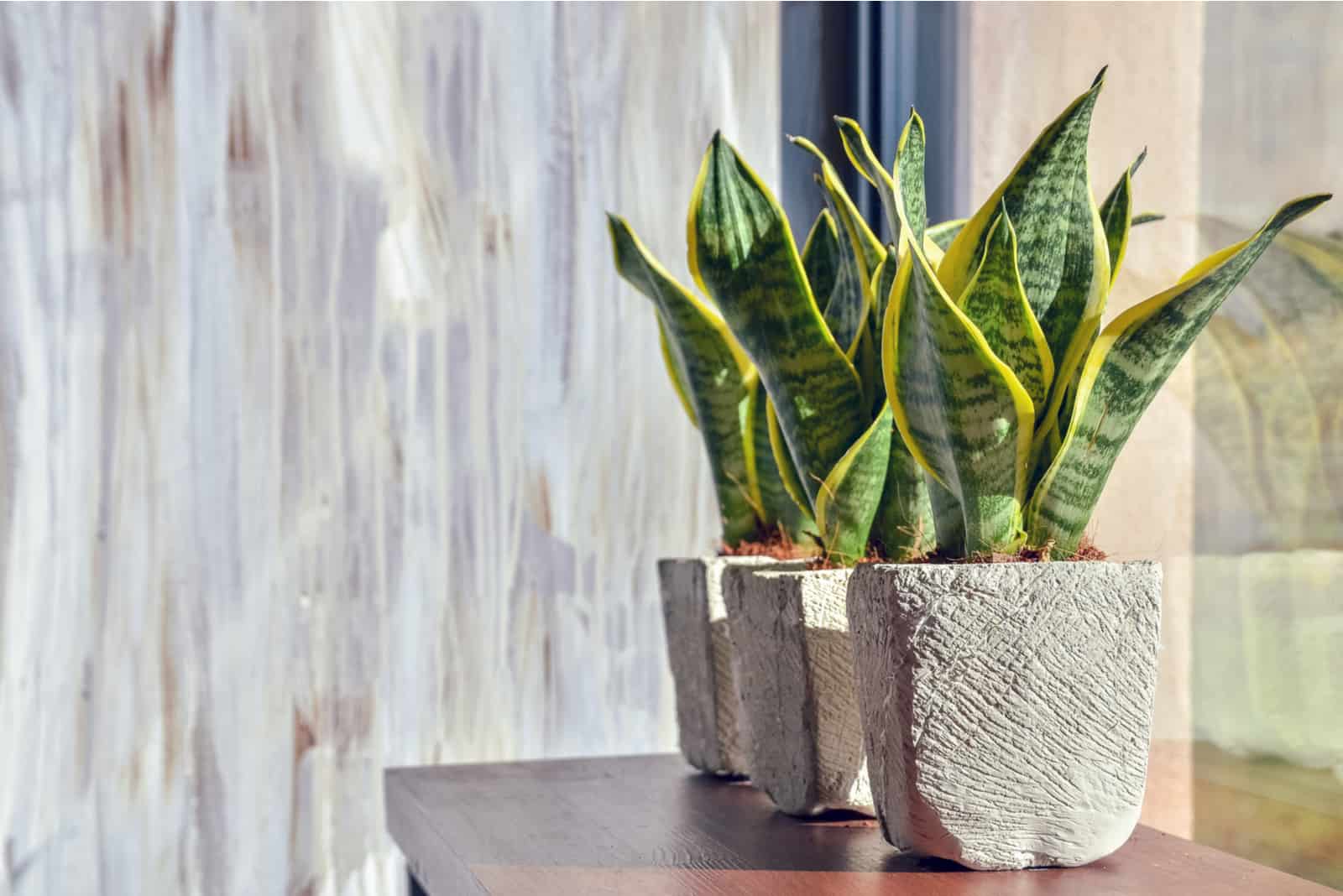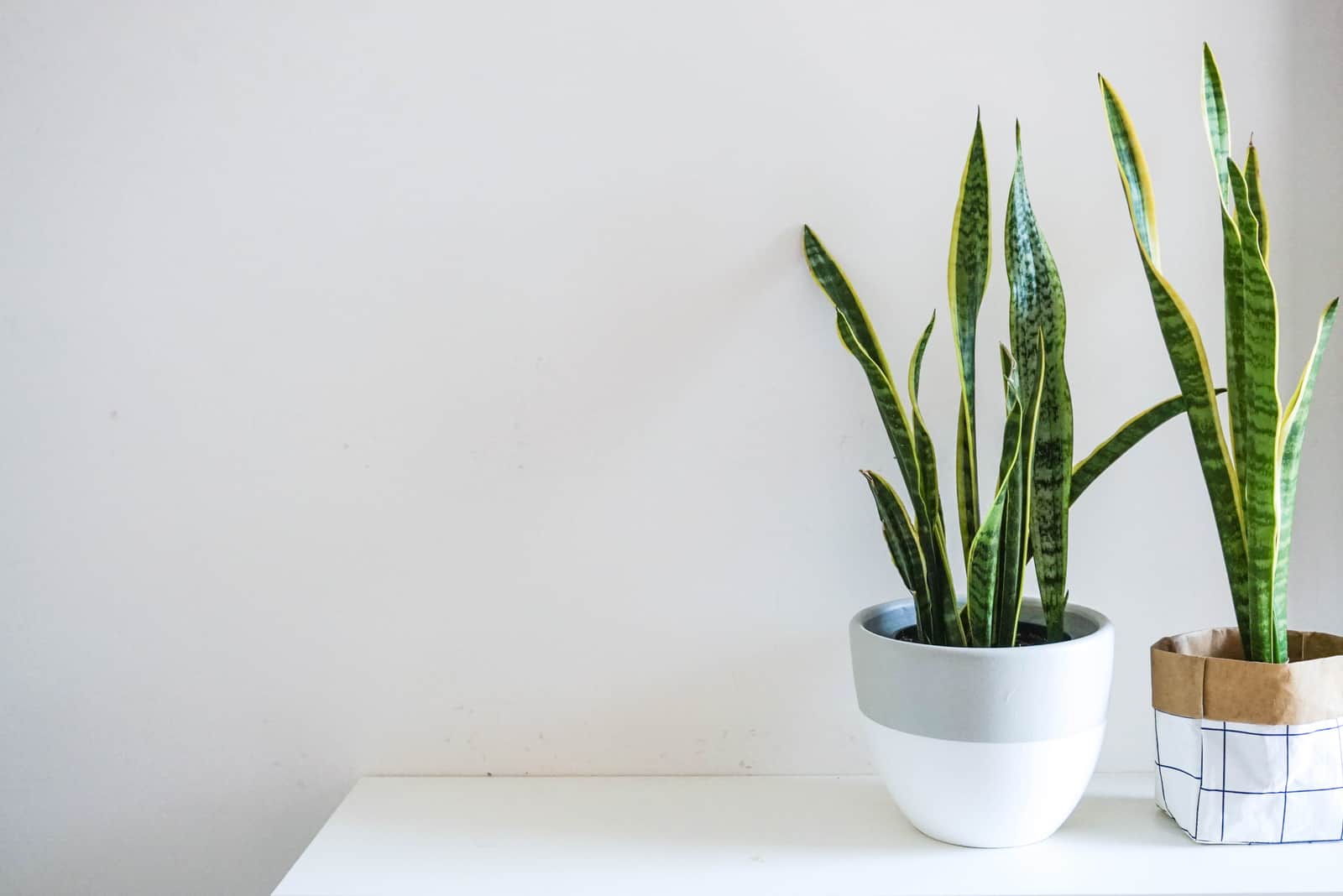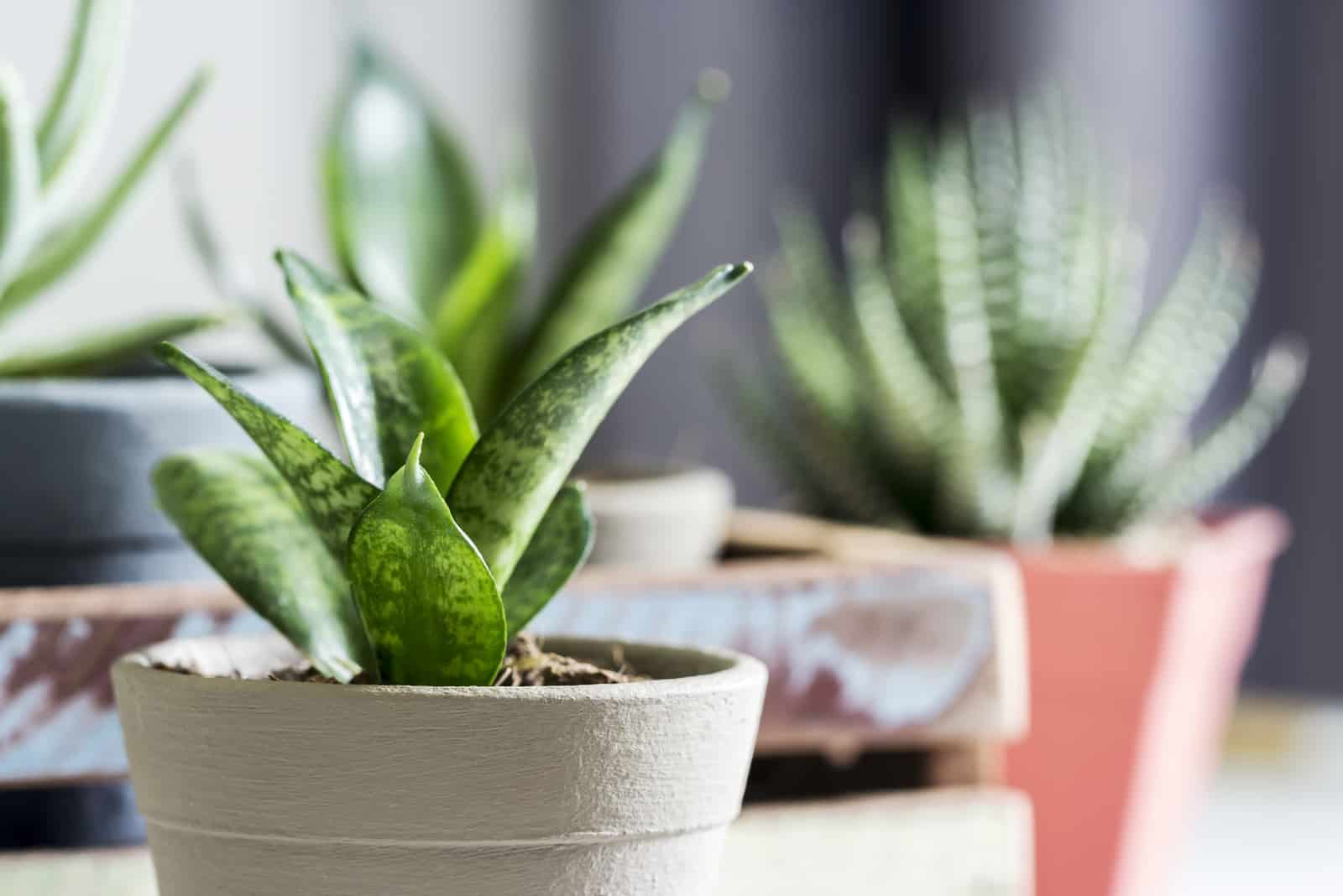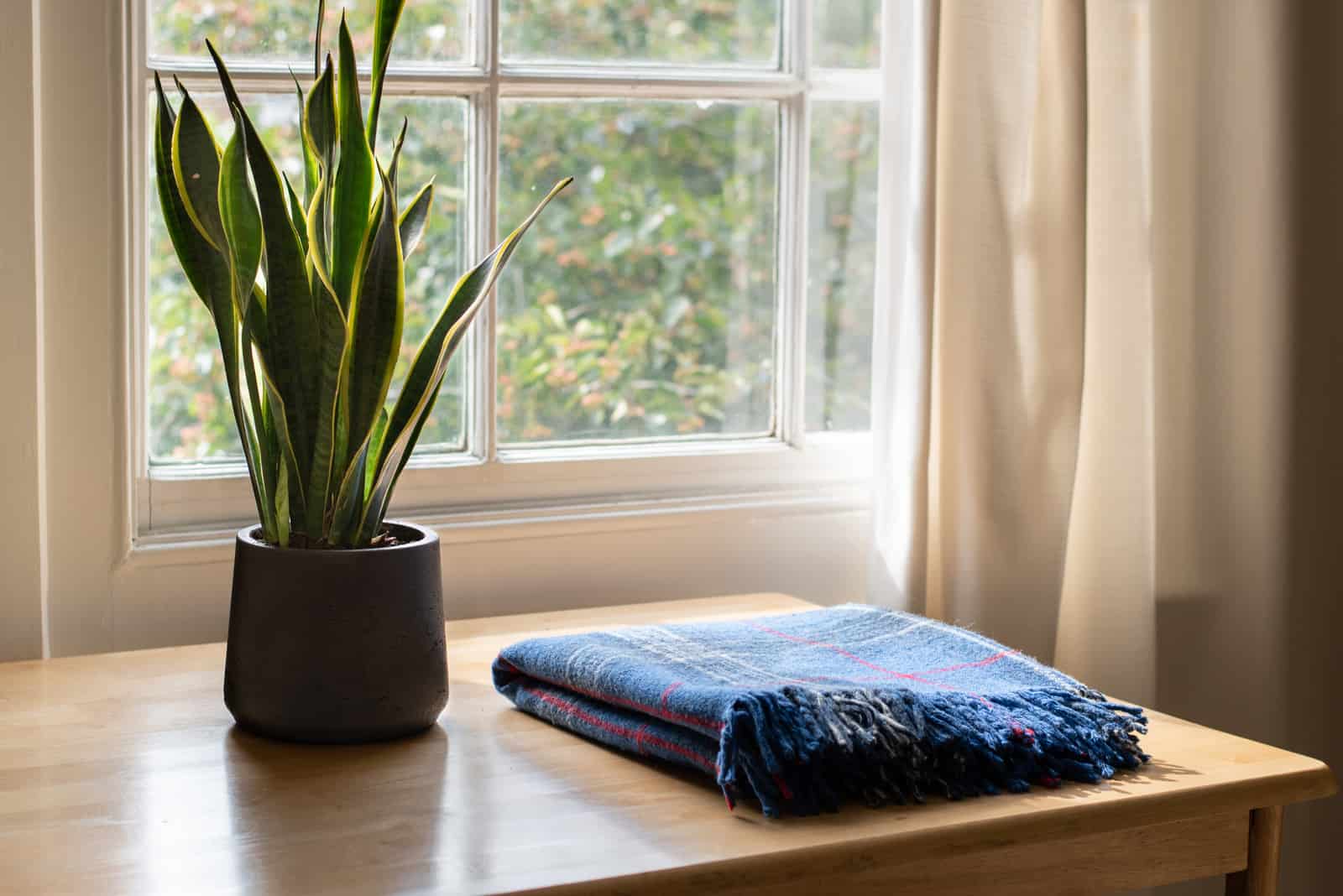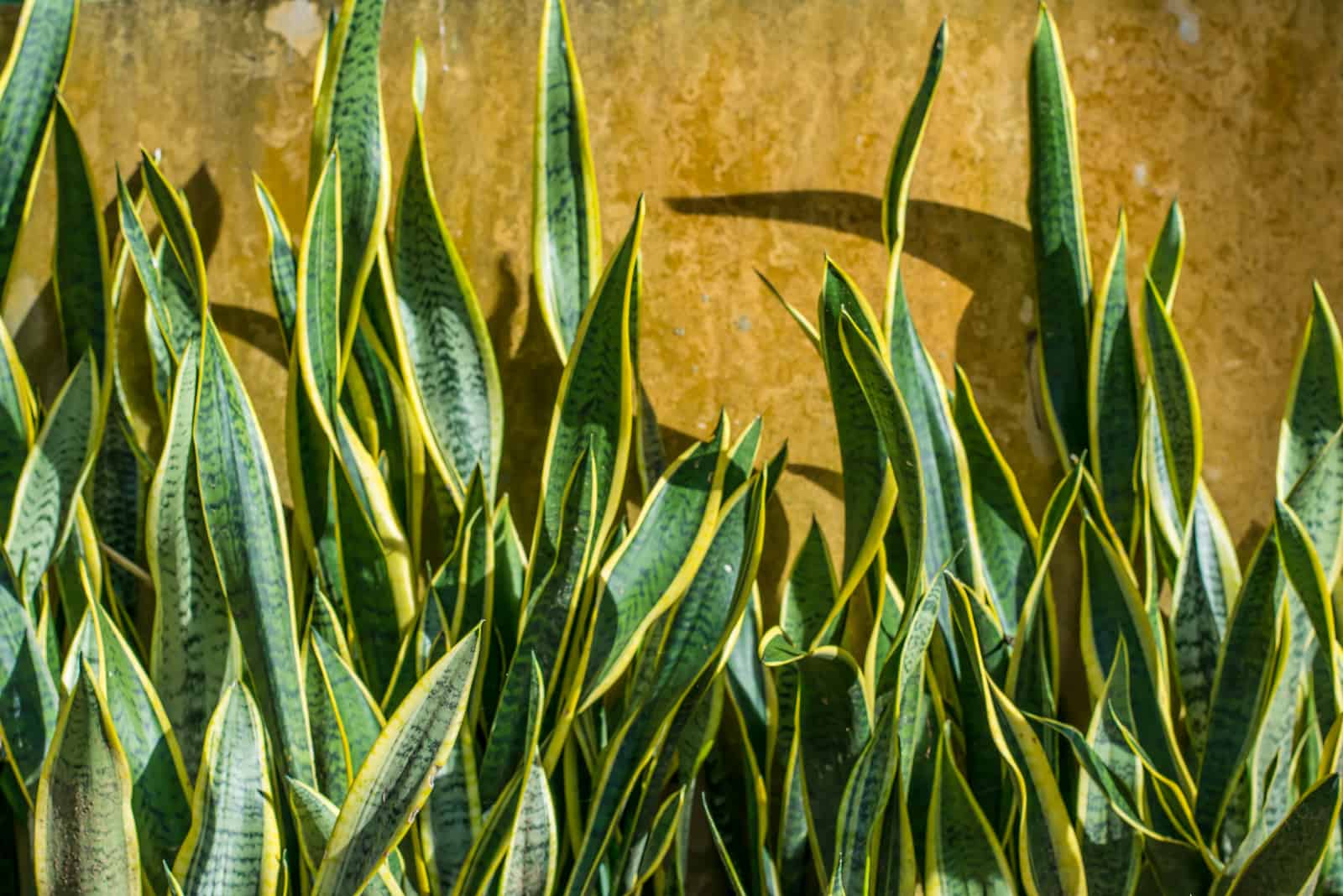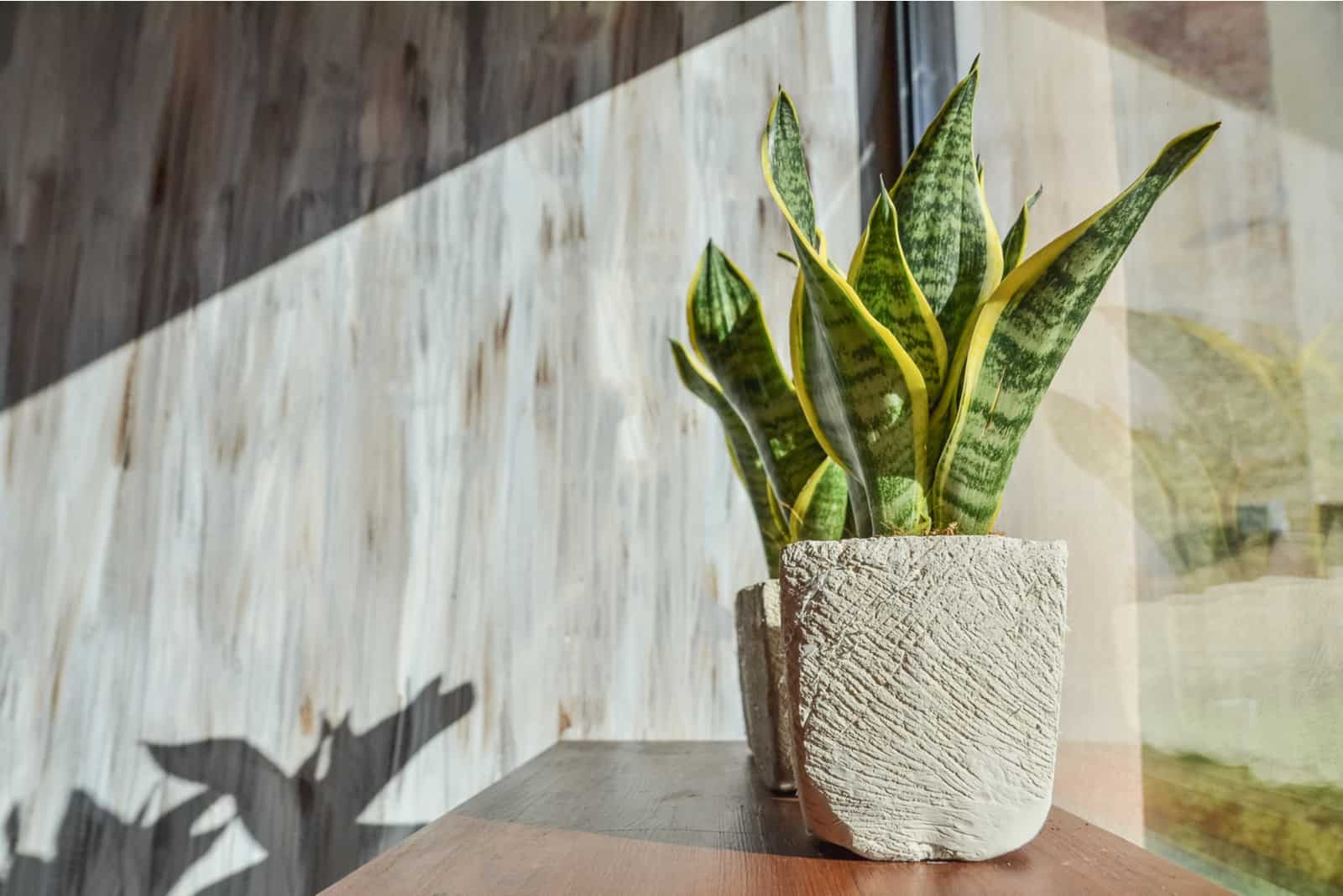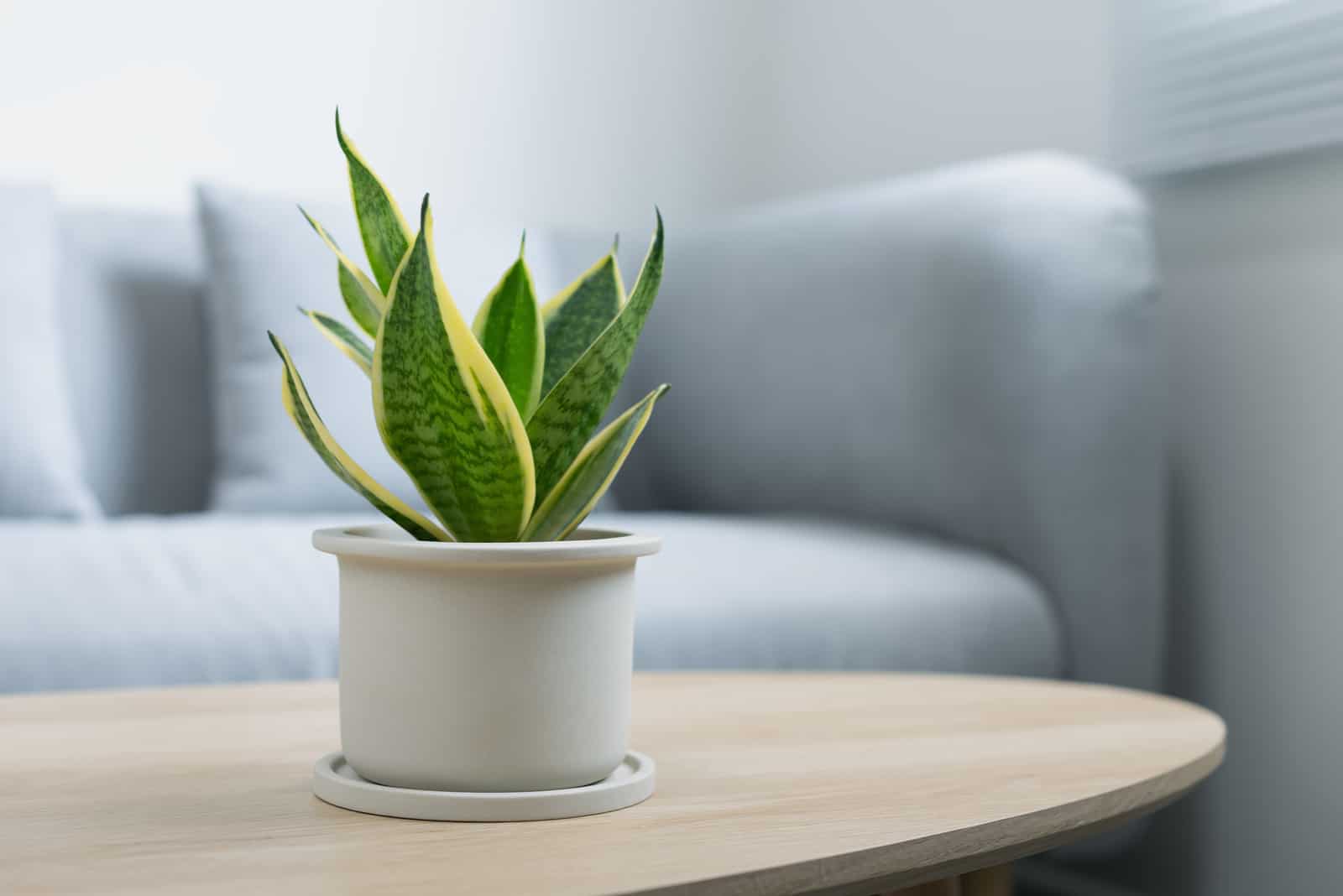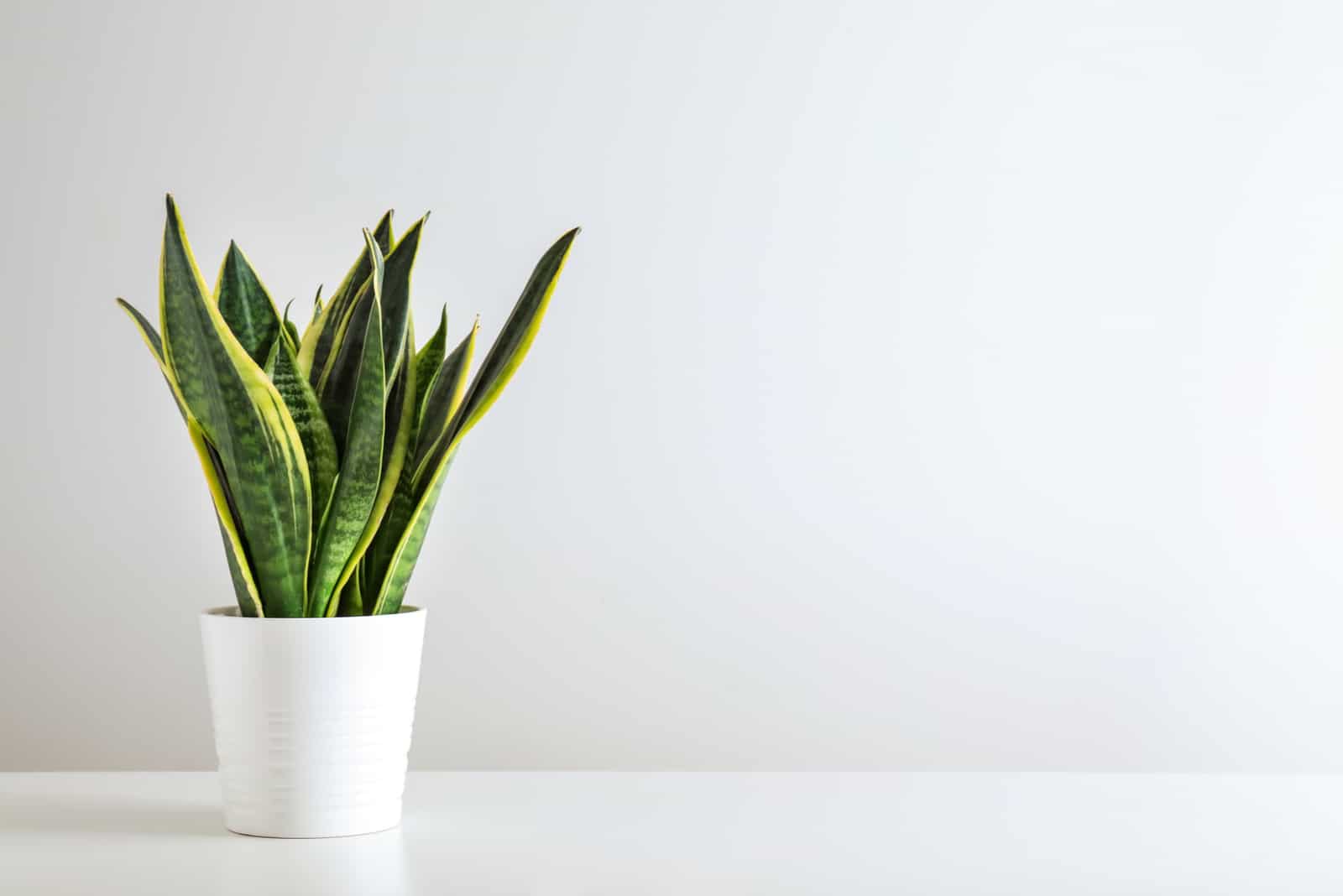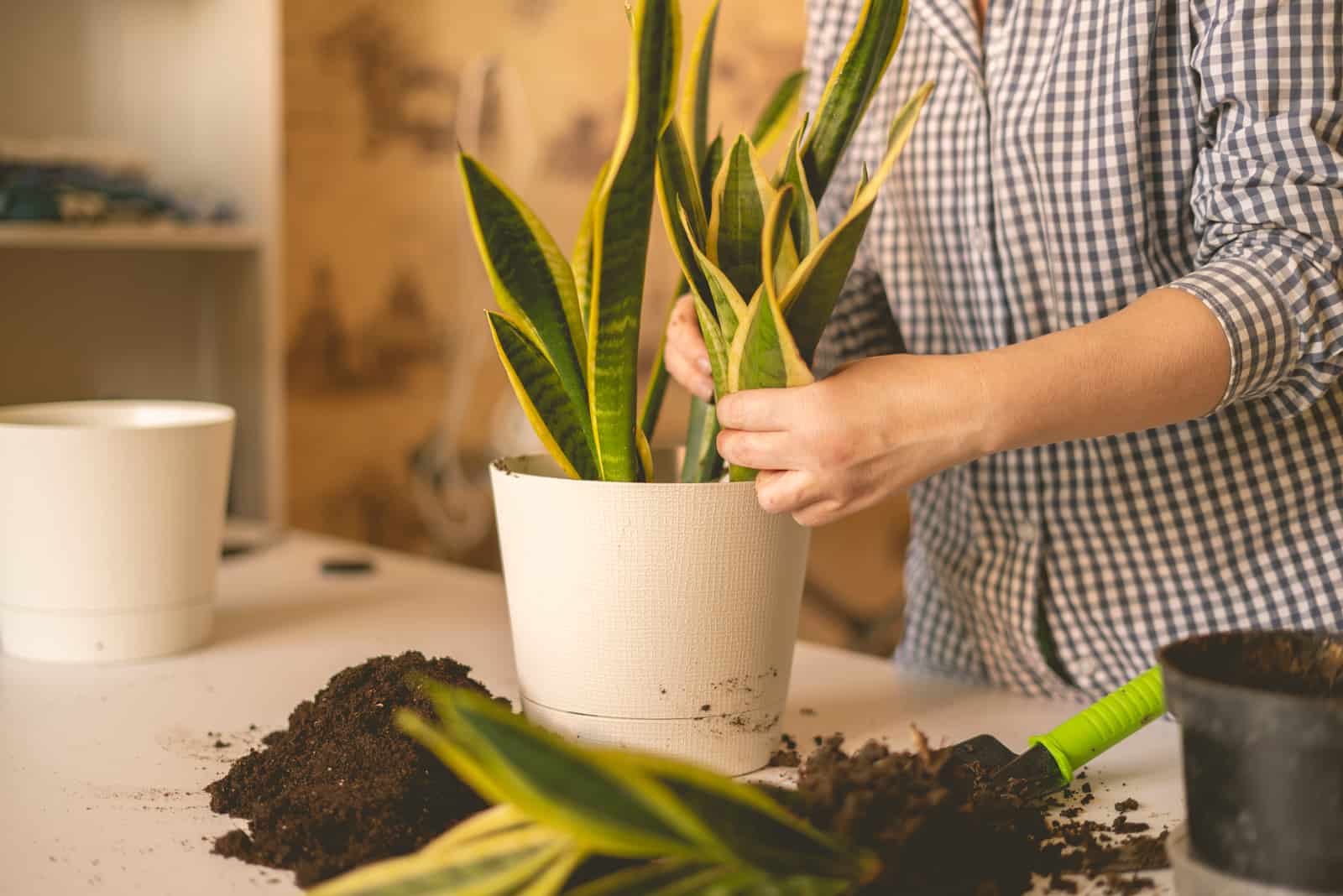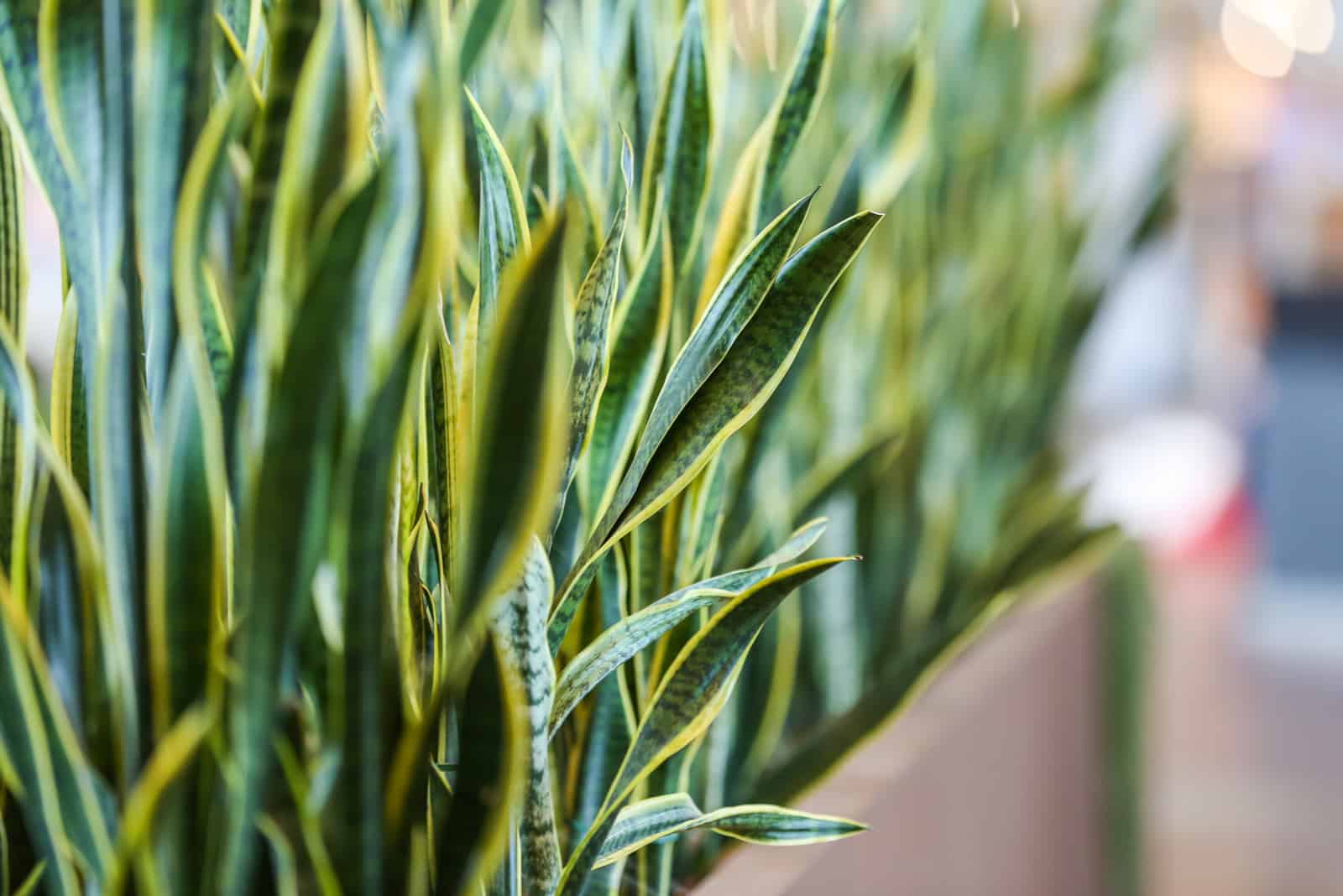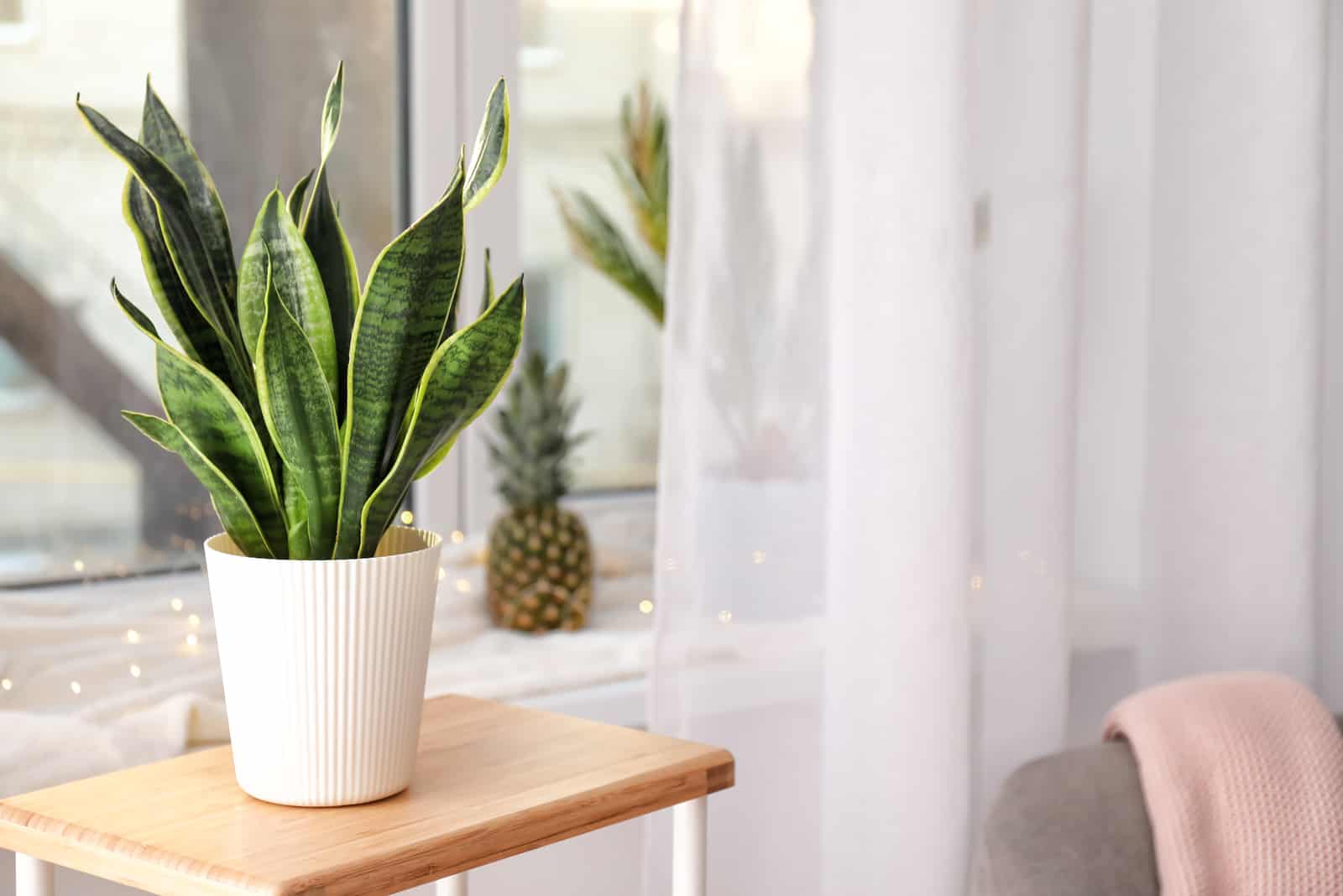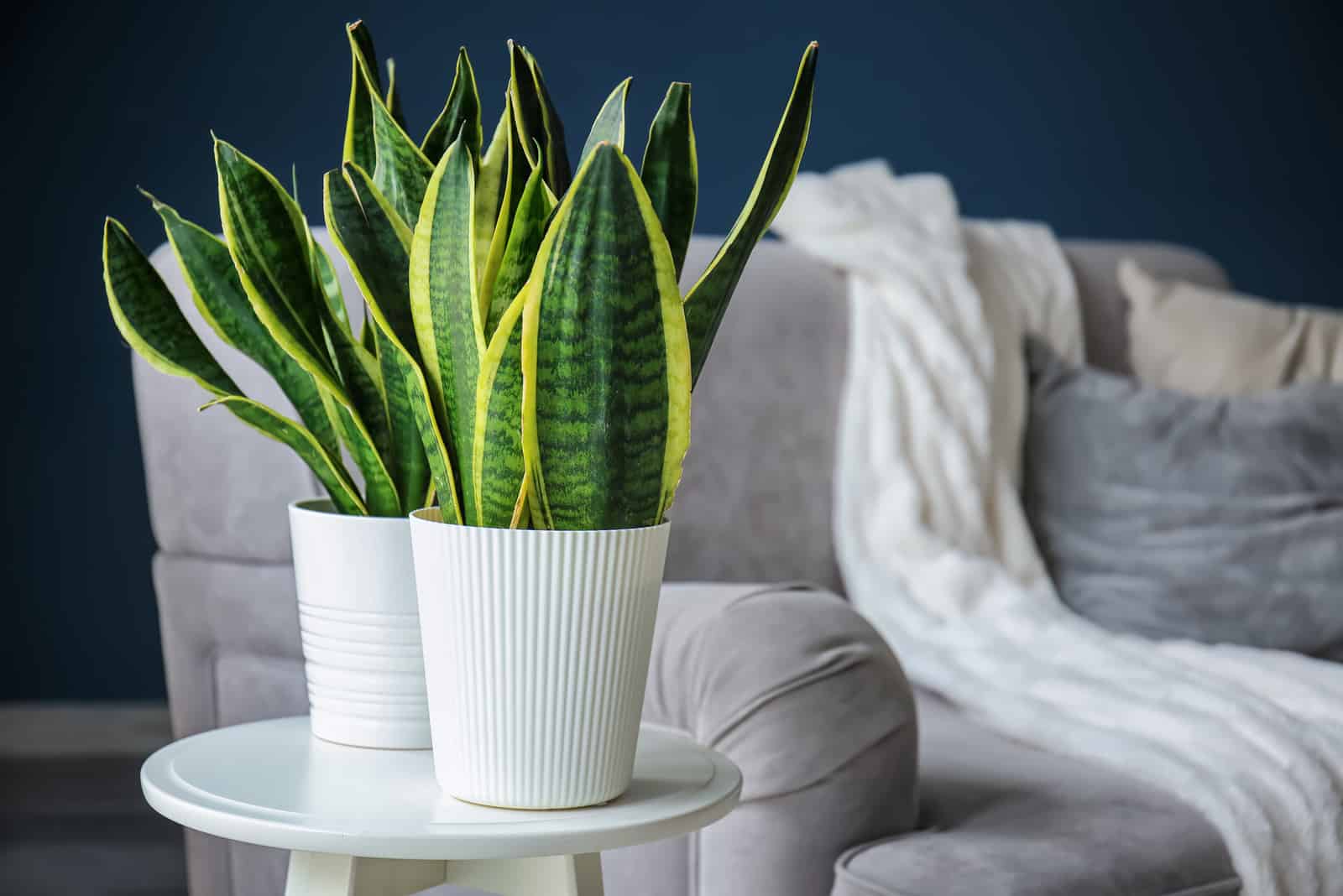Snake plants are one of the most popular houseplants nowadays, and it’s largely because they are really easy to take care of, which is why they are the perfect plants for new gardeners and busy plant enthusiasts.
Due to their ability to grow under low lights, they are ideal indoor plants for offices and dim rooms.
According to NASA, these plants are actually able to purify the air in your room! How cool is that?
Not only will these air purifying plants improve the air quality around you, but they will also make your space look more lively and cool with their sword-like green leaves!
The scientific name of Snake plants is Sansevieria Trifasciata, however they are also known as Mother-in-law’s tongue, Viper’s bowstring hemp, and Saint George’s sword.
Here is some general information about this plant:
| Common Name: | Snake plant, Viper's bowstring hemp, St. George's sword |
|---|---|
| Botanical Name: | Sansevieria trifasciata |
| Family: | Asparagaceae |
| Plant Type: | Evergreen, perennial |
| Mature Size: | Six inches to 8 feet tall |
| Sun Exposure: | Shade to partial sun |
| Soil Type: | Sandy, well-drained |
| Soil pH: | Slightly acidic to slightly alkaline |
| Bloom Time: | Spring (blooms are rare) |
| Flower Color: | White |
| Hardiness Zones: | 9–11 (USDA) |
| Native Area: | West Africa (tropical) |
| Lineage: | Eukaryota › Viridiplantae › Streptophyta › Streptophytina › Embryophyta › Tracheophyta › Euphyllophyta › Spermatophyta › Magnoliopsida › Mesangiospermae › Liliopsida › Petrosaviidae › Asparagales › Asparagaceae › Nolinoideae › Sansevieria |
| Toxicity: | Toxic to cats and dogs |
If you have been thinking about getting one of these plants, then there are some snake plant disadvantages you should be aware of.
Let’s take a look.
What Are The Snake Plant Disadvantages?
In spite of the popularity of these low-maintenance snake plants, there are some difficulties that come with them. Nonetheless, they aren’t major issues that cannot be dealt with. If there were, then you wouldn’t see a Snake plant in every other house, would you?
Let’s discuss the main Snake plant disadvantages, and see whether any of them would put you off buying one of these plants.
1. Bad Luck
I don’t know if you are superstitious, but you should know that it is believed that this plant brings bad luck, negative energy, and poverty.
I personally haven’t experienced any of these problems, and the energy in my room has only improved since I got my snake plant.
Anyway, Feng shui experts say that it isn’t the plant that brings the bad luck, but rather the place in which the plant is kept. They say you should keep your Snake plant near wooden elements and in a eastern, southern, or southeastern corner.
It is believed that they bring positive energy and good luck when in these corners.
As well as that, it’s thought that snake plants don’t enjoy being in crowded places. When they are in crowded areas, they may express negative energy around the room.
So, it would be best to keep your snake plant in a low-traffic area as when the snake plant is alone, it’s about positive vibes only!
2. Toxicity
They aren’t called snake plants for no reason! Unfortunately, these plants are toxic for humans and pets, so it’s very important to keep kids and pets away from this plant.
Snake plants contain a toxic chemical known as Saponin, which is found in every part of the plant, especially the leaves, flowers, rhizomes, and roots.
This toxic chemical can lead to some gastrointestinal issues, as well as tongue numbing and throat swelling. Ingesting large amounts of it can lead to vomiting, nausea, abdominal pain, and drooling. Even touching the plant should be avoided if you have sensitive skin as its juices can cause dermatitis or a rash.
It is much more dangerous for pets as it can lead to poisoning.
Nonetheless, these plants need Saponin because it acts as a natural insecticide that repels bad insects and pests. Sometimes, snake plant juices are used as herbal remedies, but only for topical application, as it’s never a good idea to eat something poisonous!
3. Slow Growth
Another disadvantage of the snake plant is slow growth, especially when it is grown indoors. Although this plant can grow up to 6 or 7 feet tall, it does so pretty slowly, so if you are planning to grow a dense garden in a short amount of time, snake plants might not be the best plants for it.
When grown indoors, they grow in small pots and containers, so the roots of your plant don’t have space to spread and grow, which is why they rarely grow new leaves.
Even propagation is not useful in this case, because it takes a few months for small roots to start growing.
However, this plant might be perfect for those who don’t have time to spend pruning.
In case you want to boost up your snake plant’s growth, you should provide it with an adequate potting soil and repot it in larger pots.
4. Leaves Falling Over
The main reason these snake plants are so popular is because of their beautiful plant leaves, which lighten up the dark corners of your room.
Plant leaves are the first thing we see on a snake plant, so you might be pretty bummed out when these start falling off or changing color. If this happens to your plant, you should pay close attention to it because leaves changing color or shape is usually a sign that something is wrong with your plant.
Issues like overwatering, poor potting conditions, and insufficient light exposure might be the reasons why the leaves of a snake plant start changing and falling off.
It could also be poor potting conditions, so you should provide your plant with high-quality potting mix that contains all of the essential nutrients for growth and development. Pot size is also important, as too large a pot can provide enough space for fungi breeding, and root rot is likely to occur because of overwatering. However, small pots might not provide enough space for the roots so they might end up bound, which affects water and nutrient intake.
We have already mentioned overwatering. The leaves will soak up excess water and they might get too heavy and fall off. So, not only can frequent watering lead to root rot and affect the overall health of your plant, it can also ruin the magnificent dark green leaves.
Light conditions are a gray area for these plants. They aren’t picky when it comes to light conditions, yet leaving them for too long in a dark location can be the reason the leaves start to fall off. You can provide them with artificial lights, like incandescent and fluorescent, if you place it somewhere with no natural light source.
5. Irregular Flowering
You probably bought yourself a snake plant because of its decorative leaves, but did you know that they can also produce flowers?
That’s right! Some snake plant varieties, like the Sansevieria Cylindrica, actually start flowering at the beginning of the growing season, although others bloom rarely.
Slow growth applies to the flowers as well, and you could have to wait a couple of years to find out whether your snake plant is flowering or not. Nonetheless, the leaves are standing there, looking pretty and all!
6. Propagation Problems
First, you have to be a skilled gardener to properly cut the leaves and not cause any damage to your plant. Most snake plants get hurt during propagation because it is quite tricky to cut them properly.
Aside from that, propagating in water might lead to root rot. It’s very important to learn how to properly propagate your plant if this is something you want to do.
For proper propagation, check out this video:
7. Temperature Requirements
As they have tropical origins, snake plants thrive in hot and wet climates. Somewhat surprisingly, they can also tolerate some cold temperatures, but not too cold though as they are not frost-hardy and can’t be kept outside during the winter.
The ideal temperature for snake plants ranges from 55 to 85 degrees Fahrenheit during the daytime, and from 50 to 75 degrees Fahrenheit during the nighttime.
Any higher temperature can lead to the development of brown rings on the leaves, as well as wrinkly leaves. Any lower temperature can permanently damage your snake plant, especially if it’s mixed with soggy soil.
8. Overwatering
Snake plants are considered to be low-maintenance primarily because they don’t require that much watering and can tolerate drought. They are known for requiring less water than other houseplants, but sometimes even very infrequent watering can be too much for your snake plant.
They don’t like having soggy soil as it can lead to root rot. You might notice changes in the color of the leaves if this happens, and if they start turning yellow and looking kind of droopy, it’s a major indicator of overwatering.
If you continue with the same watering schedule, the roots will become mushy to the point where you can no longer save your plant.
It can be quite tricky to determine how much water your snake plant needs because there are other contributing factors, such as the type of snake plant, temperature, humidity, light conditions, and so on, which is why this is probably the biggest snake plant disadvantage.
9. Prone To Pests & Fungi
We have covered almost all the disadvantages of snake plants. The last snake plant disadvantage is their fungal susceptibility.
Although they don’t attract insects, some fungi can infect your plant and cause diseases like red leaf spot and southern blight, which unfortunately appear mostly on the leaves and make them look less appealing. You can prevent this by using fungicide.
They are also prone to pest infestation, especially mealybugs and spider mites, which love munching on those delicious and juicy leaves. To get rid of them, you can use neem oil or pesticides.
What Are The Snake Plant Benefits?
Now that we have covered the snake plant disadvantages, let’s look at the good stuff! We already know they are air purifying plants that are easy to take care of, but is there more?
Of course there is!
Read on to discover all the snake plant benefits.
1. Remove Air Pollutants
We previously mentioned that they are able to improve indoor air quality, but have you ever wondered what the toxic pollutants in the air are?
The toxic pollutants (some of which are cancer-causing) that can be absorbed by a snake plants are:
• Trichloroethylene
• CO2 – Carbon dioxide
• Toluene
• Xylene
• Benzene
• Formaldehyde
Trichloroethylene is commonly found in paints, printing inks, adhesives, dyes, and varnishes, and it may cause respiratory tract irritation, which leads to headaches and nausea.
We all know that we breathe out Carbon dioxide, which can build up in small spaces like classrooms and offices. High concentrations of Carbon dioxide in the air can affect our ability to learn and process, and it can also cause nausea and fatigue. But, our little snake plant can effectively absorb CO2 from the air, which is a major benefit for our well-being!
Toluene is found in gasoline, paints, plastics, and cosmetics. It has been proven that toluene can affect our mental health and nervous system, causing different dysfunctions and abnormalities. It can lead to development issues in children whose mothers were exposed to high amounts of toluene.
Benzene can be found literally everywhere: cigarette smoke, air conditioners, heating systems, paints, etc. Benzene can cause headaches, vomiting, and nausea, and long exposure to benzene can disrupt your blood cells and cause mutations, which can lead to cancer. It has been proven by NASA that a Snake plant (especially Mother-in-law’s tongue) has the ability to absorb about 50% of benzene.
Formaldehyde is also widely distributed, from cosmetics, fuels, and smoking, to cooking, paints, and new furniture: they are all considered as sources of formaldehyde. It can cause eye, nose, and throat irritations, which lead to breathing problems.
2. Herbal Remedies
Although we know it’s poisonous, plant experts suggest that we can use this plant in herbal medicine, and there have also been some studies that concluded that Snake plant extracts have antipyretic and analgesic effects, which can help:
• Relieving headaches
• Improving immune system
• Healing skin with burns, scars, and wounds
• Removing parasites
• Keeping the blood pressure normal
• Reducing inflammation
You should only apply Snake plant extracts on the exterior of your body. Do not eat or drink any part of your snake plant, and always consult with a doctor before applying it!
Though saponin can be found in laxatives, choleretic, and diuretic drugs, ingesting large quantities can pose some serious health issues.
3. Natural Air Filter
It is a feature of the group of plants called CAM to perform a special type of photosynthesis, in which carbon dioxide gets absorbed during nighttime and oxygen then gets released.
The Snake plant is a CAM plant, and another example would be a succulent.
This means that while you are busy sleeping, your plant is working hard to convert carbon dioxide into oxygen, thereby improving your indoor air quality.
Even though we can’t see it with our own eyes, these plants definitely reduce carbon dioxide levels in a chambered room.
4. Feng Shui
Snake plants have been used in Feng Shui for quite some time. It is believed that they are able to absorb negative energies as per Vastu, and bring out positive energies and joyfulness in the area.
It is also believed that those spiky leaves which look like swords are able to protect your house from the negative Chi.
In Feng Shui, it’s important to respect the recommended position in order to achieve the benefits that come with your plant, so if you want positive vibes in your home, place your Snake plant in an Eastern, Southern, or Southeastern corner.
Make sure that the room doesn’t get crowded and enjoy the positive vibes (sometimes having snakes in your life can be a good thing, but only if they are plants!).
5. Allergies
As it has the ability to remove toxic pollutants from the air, it can also reduce the level of airborne allergies such as dust, spores, dander, etc.
They produce oxygen and improve indoor air quality, which has a significant impact on airborne allergies. It has been proven that air quality is linked to health, especially in terms of airborne allergens.
Don’t spend money on an air purifier, just surround yourself with snake plants and enjoy some good and quality air!
6. Ornamental Purposes
Even if we don’t take into account all the advantages of snake plants that we previously discussed, their unique appearance should make you want to buy them immediately!
They have strong, dark green leaves that look like swords. As well as that, the leaves have different colors and can be green at the center before changing into a beautiful yellow color around the edges, making it look like a golden frame for the leaves. Mother Nature truly is the best artist out there!
The leaves can sometimes be variegated as well, making it look even more exceptional.
7. Low Maintenance
Another exceptional thing about this plant is its ability to survive in harsh conditions without almost any water and light.
The snake plant is perfect for both gardening beginners and plant lovers that are super busy and don’t have much time to spend on their plants.
We are now going to look at a snake plant care guide, so stay tuned!
Water Requirements
Or should I say Water needlessness?
The snake plants are drought-tolerant and can survive for a long time without water. So, it shouldn’t be a problem if you forget to water your snake plant every now and then.
You should provide it with a little bit of water though. During hot summers, you should water it every two weeks, however, you can ease up with the watering during the colder season. It should be enough for your plant to stay happy and healthy if you water it once every 6 weeks.
Please be careful when watering as this plant can easily be overwatered, which leads to root rot that can destroy your plant if not treated in time. There goes the air purifier, positive energy, and herbal medicine, all at once!
Light Requirements
You won’t have to worry too much about light requirements either, because this plant is versatile and can grow in various different light conditions.
It can grow in full sun, though it is one of the plants that prefer low light areas, which is why corners of rooms are perfect places for them.
However, being exposed to direct sunlight for too long might cause the leaves to burn.
Soil Requirements
You can grow your snake plant either indoors or outdoors, but when it comes to soil preferences, it prefers well-draining soil with pH ranging from 5.5 to 7.
You can use cactus or succulent potting mix for any snake plant cultivar.
Pruning & Fertilizer
This plant is a slow-grower, and it won’t need frequent pruning or fertilizing. You can fertilize your plant once a year, and I would recommend you use universal fertilizer as it will provide plenty of nutrients for your plant throughout the year.
Frequently Asked Questions
1. Is a snake plant bad for the home?
In my opinion, no, it isn’t bad for your home. In fact, its ability to purify and improve indoor air quality, applications in herbal medicine, decorative features, and positive impact on mental health and overall well-being makes it a great plant to grow in your home!
I have to mention that some people believe that it brings bad luck and poverty, but in terms of Feng Shui, this is completely wrong.
As per Vastu, it is believed that it brings positive energy and repels negative energy with the spikes on the leaves. It is important that you put it in the right place for it to attract positive vibes and joyfulness.
2. What are the different types of Snake plant?
The Sansevieria genus has about 70 different species!
Their leaves differ from one type to another, and they grow disparately in terms of height. Here is a list of most popular snake plants:
• Mother-in-law’s Tongue or Sansevieria Trifasciata — reaches about 3 feet with its spiky, dark green leaves.
• Bird’s nest snake plant or Sansevieria Hahnii — this is a dwarf cultivar that grows leaves in clusters which resemble a bird nest.
• Sansevieria Laurentii — it can grow about 30 inches tall and has dark-green leaves with yellow borders that grow in a zig-zag pattern.
• Sansevieria Cylindrica ‘Boncel’ — this is a unique plant that grows leaves in the shape of a queen’s crown.
• Rhino grass or Sansevieria Pearsonii — it produces clumps of straight leaves.
• White snake plant or Sansevieria trifasciata “Bantel’s Sensation” — this is a statement plant that grows large leaves with prominent, white stripes all over them.
• Sansevieria ‘Black gold’ – this is one of the most desirable cultivars because it grows wavy, deep green leaves with yellow stripes around the edges.
3. What do snake plants do to you?
Snake plants contain a toxic chemical called Saponin. If this toxic chemical is ingested in large amounts, it can cause nausea, vomiting, and swelling of the throat and tongue.
Snake plant extract is used for wound healing in herbal medicine, though it should only be applied to the exterior of our body.
In terms of health benefits, it is proven that snake plants are able to absorb bad pollutants from the air and improve indoor air quality.
They can also have a positive affect on your mental health and lower your allergies by absorbing airborne allergens.
In addition to this, it can also make your home look much more lively and attract positive energy.
4. How often should snake plants be watered?
Snake plants should be watered once every two weeks during hot summers. When the winter comes, it should be watered once every 6 weeks. Snake plants are drought tolerant, which is why they can be left without water for a while.
However, snake plants are prone to overwatering, which can lead to root rot. Ease up with watering if you notice any leaves turning yellow.
Final Thoughts
Now that we have covered the Snake plant disadvantages and advantages, it should be easy to decide whether you want to buy a snake plant or not.
In my opinion, you should go for it!
This plant is easy to take care of, has a lot of benefits, and can actually improve your well-being and home decor. As well as that, it attracts positive energy and fights off the negative!
Though it is poisonous, which is a major drawback, it can be easily kept away from kids and pets. Just keep it on a shelf and warn your little ones not to touch it.
Other snake plant disadvantages are easily dealt with and should not pose any major issues.
If you decide to buy a new snake plant, then prepare yourself for joyfulness in your home and enjoy the high-quality, purified air. 🙂
Until next time!

